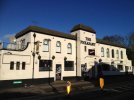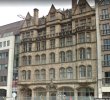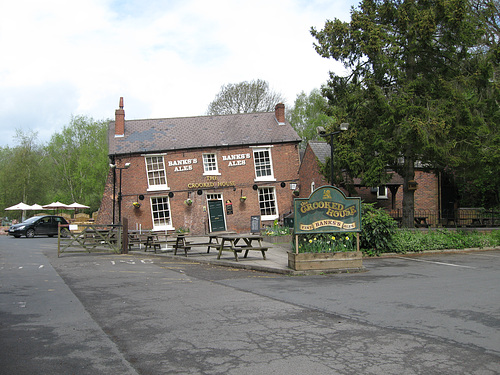Richard Dye
master brummie
Such a shame! You have to wonder what happened, apparently they were doing so well!Here's an update on The Pheasant pub.
Demolition work on Smethwick pub left unsafe by 'third party works' begins | Express & Star
Such a shame! You have to wonder what happened, apparently they were doing so well!Here's an update on The Pheasant pub.
Demolition work on Smethwick pub left unsafe by 'third party works' begins | Express & Star
Have tube very careful digging the cellar out on older buildings, you never know what you are going to find!Apparently they tried to reinforce the building with steel girders inside, and made it unsafe instead. They probably shouldn't have dug the cellar out either! Finally it was just a shell.
You mean the bodies of ex landlord's wives?Have tube very careful digging the cellar out on older buildings, you never know what you are going to find!
You mean the bodies of ex landlord's wives?
In happier days...Here's an update on The Pheasant pub.
Demolition work on Smethwick pub left unsafe by 'third party works' begins | Express & Star

Srokkie, that is what we call in the US ”snatching defeat from the jaws of victory”!A blunder. Sorry to see this.
Despite the wholesale slaughter of beautiful buildings in Birmingham, that has happened a few times here as well - here is an example in Paradise Street facing the Town Hall, a former shops & office front remains while a new main building was constructed behind it.FWIW, in downtown Detroit and some other cities, old buildings are shored up at the front with heavy steel structures to maintain the facade and entrances, while a new building is constructed behind and tied to the piece of history facing the street.

A traditional pub obviously needs a cellar, but I guess many younger people are unfamiliar with these. I never drank there, but went to The Thimble Mill, The Abbey, Bear Hotel for music, Kings Head, The Talbot (Dirty Bett’s), The Hen and Chickens, and on the High Street, The Red Cow. Some of these survive.Srokkie, that is what we call in the US ”snatching defeat from the jaws of victory”!
In the older or traditional pubs the cellar was really there to keep the beer cool, today the beer is is kept in coolers in kegs under the counter or close by.A traditional pub obviously needs a cellar, but I guess many younger people are unfamiliar with these. I never drank there, but went to The Thimble Mill, The Abbey, Bear Hotel for music, Kings Head, The Talbot (Dirty Bett’s), The Hen and Chickens, and on the High Street, The Red Cow. Some of these survive.
Lloyd, that's a beautiful example of retained architecture that needs to be maintained and appreciated instead of facing the wrecking ball, only to be replaced by faceless reflective mirror glass frontages that are so popular world-wide today.Despite the wholesale slaughter of beautiful buildings in Birmingham, that has happened a few times here as well - here is an example in Paradise Street facing the Town Hall, a former shops & office front remains while a new main building was constructed behind it.
View attachment 171887
When my wife's cousin Freddie ran the Shelton Inn in Halesowen before retiring, he took me down for a tour of his pride and joy, the well-organized cellar, maintained at I believe was 56 degrees. A large pipe affectionately known as the "Python" ran from the barrel piping, up around the wall of the staircase, into the bar and lounge. The building was originally a mill, fed from the adjacent stream.A traditional pub obviously needs a cellar, but I guess many younger people are unfamiliar with these. I never drank there, but went to The Thimble Mill, The Abbey, Bear Hotel for music, Kings Head, The Talbot (Dirty Bett’s), The Hen and Chickens, and on the High Street, The Red Cow. Some of these survive.
Richard, yes, I suspect that when this pub was demolished and rebuilt in 1930s, the Victorian cellar was retained. Most beer is in keg under gas, but some ales are in metal casks without gas. I know some breweries who still deliver with horses, but I’m less sure who might still retain barrels. I’m currently in Norfolk where cask beer is widely available. The British tradition of warm beer survives. https://camra.org.uk/learn-discover/discover/00IMIn the older or traditional pubs the cellar was really there to keep the beer cool, today the beer is is kept in coolers in kegs under the counter or close by.

Stokkie, back in 2000, one of the units I was running what is the largest manufacturer of beer kegs in the US. They were made out of 304 stainless steel and while we made a lot of kegs in the US it was nothing compared to the European manufacturers. During the eight years running that business unit, I got so much different feedback from different breweries.The warm beer irony in the US he’s actually a bit of a myth. Most breweries recommend that the beer is is served between 45 and 48° F, which is just a little cooler than many cellars in the UK. In the US there has been a resurgence of what are called craft beers, this brings them much closer to the beer from the UK. As long as they are cool and wet and taste good, I’m OK with thatRichard, yes, I suspect that when this pub was demolished and rebuilt in 1930s, the Victorian cellar was retained. Most beer is in keg under gas, but some ales are in metal casks without gas. I know some breweries who still deliver with horses, but I’m less sure who might still retain barrels. I’m currently in Norfolk where cask beer is widely available. The British tradition of warm beer survives. https://camra.org.uk/learn-discover/discover/00IM
I remember the crooked house when it was genuine and you could truly be puzzled by a coin apparently running uphill on a table. Then they refurbished it and put in artificial crookedness which was exaggerated. Not the sameTwo pubs in the Black Country survive. Ma Pardoes in Netherton and The Crooked House in Himley. The latter has an extension on a concrete raft which isn’t crooked, which misses the point.
I seem to remember the Crooked House, when did they refurbish it approximately?I remember the crooked house when it was genuine and you could truly be puzzled by a coin apparently running uphill on a table. Then they refurbished it and put in artificial crookedness which was exaggerated. Not the same
Richard, we have an ‘American’ craft beer trend running here, which seems to mean very hopped IPA. I’m happy to drink beer in different styles too. Like wine, stainless vats have proved to be clean and practical, DerekStokkie, back in 2000, one of the units I was running what is the largest manufacturer of beer kegs in the US. They were made out of 304 stainless steel and while we made a lot of kegs in the US it was nothing compared to the European manufacturers. During the eight years running that business unit, I got so much different feedback from different breweries.The warm beer irony in the US he’s actually a bit of a myth. Most breweries recommend that the beer is is served between 45 and 48° F, which is just a little cooler than many cellars in the UK. In the US there has been a resurgence of what are called craft beers, this brings them much closer to the beer from the UK. As long as they are cool and wet and taste good, I’m OK with that
Their website is down at the moment. The building was condemned in the 1940s and shored up. I saw it first in the early 1970s, and more lately about 8 years ago. I think it has had work done on it several times to prevent collapse. As well as perhaps to make it like a 1920s expressionist film!I seem to remember the Crooked House, when did they refurbish it approximately?

Love it! I happen to be drinking a Sweetwater IPA and will have a glass of Pino with my dinner, which is my wife’s stir fry…Richard, we have an ‘American’ craft beer trend running here, which seems to mean very hopped IPA. I’m happy to drink beer in different styles too. Like wine, stainless vats have proved to be clean and practical, Derek
I think I went there late 50’s or maybe 60/61, really just to see it, not my usual stomping grounds.Their website is down at the moment. The building was condemned in the 1940s and shored up. I saw it first in the early 1970s, and more lately about 8 years ago. I think it has had work done on it several times to prevent collapse. As well as perhaps to make it like a 1920s expressionist film!
